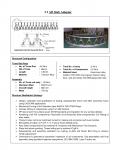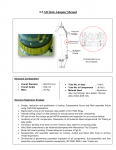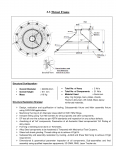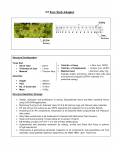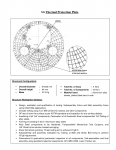Indian Space Program: News & Discussions
- Thread starter Tarun
- Start date
-
- Tags
- isro
You are using an out of date browser. It may not display this or other websites correctly.
You should upgrade or use an alternative browser.
You should upgrade or use an alternative browser.
Looks like a model of ISRO's proposed space station. You can see the gaganyaan module attached to it on one end. There is a spherical module junction between the two segments. The first photo seen of the space station(2nd pic.) had no such junction. The junction seems designed to be able to mate 6 station modules. Each module can mate with two others, one on each end.

The space station was stated to be 20 tonnes. I presumed at that time that each module will weigh about 10 tonnes and both modules will be launched separately by GSLV MK-3 and then mated in space. With the addition of the junction module I wonder how the weight will be effected. OTOH having a junction allows us to expand the space station at a steady pace whenever budget is permitting.


The space station was stated to be 20 tonnes. I presumed at that time that each module will weigh about 10 tonnes and both modules will be launched separately by GSLV MK-3 and then mated in space. With the addition of the junction module I wonder how the weight will be effected. OTOH having a junction allows us to expand the space station at a steady pace whenever budget is permitting.

The Andhra Sugars Ltd. are expanding their facilities for future ISRO demand.
Source : https://web.archive.org/web/2019123...EIA_EMP/24092018LPDP1EP0ASLFinalEIAReport.pdf
Plant Layout of M/s. The Andhra Sugars Ltd. for proposed expansion of their facilities :

Details of product and production volume :

Manufacturing processes involved :
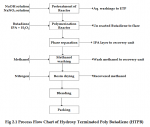
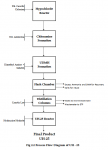


Project proposal :
The proposal is for expanding manufacturing capacity of Hydroxy Terminated Poly Butadiene (HTPB), UH-25 (UDMH-75% + HH 25%), Monomethyl hydrazine (MMH) and inclusion of Isrosene. These chemicals are manufactured for exclusive use as propellant for satellite launch vehicles like PSLV and GSLV by Indian Space Research Organization (ISRO) Department of Space, GoI. The project site is located in notified industrial area of Ventakarayapuram Industrial Area Township vide G.O.Ms. No. 14 dated 06.04.1998. It is proposed to utilize existing site area of 5.9 acres for proposed expansion in the integrated sugar complex of The Andhra Sugars Ltd., spread over 109 acres located at Sy. No. 541, 545 and 539, Venkatarayapuram Industrial Area Town Ship, Tanuku Mandal, Andhra Pradesh.
The terms of reference for the environmental impact assessment studies was obtained from Andhra Pradesh State Environmental Impact Assessment Authority (SEIAA) vide letter no. SEIAA/AP/WG/IND/03/2018/538 dated 14.05.2018 as part of the environmental clearance process.
Source : https://web.archive.org/web/2019123...EIA_EMP/24092018LPDP1EP0ASLFinalEIAReport.pdf
Plant Layout of M/s. The Andhra Sugars Ltd. for proposed expansion of their facilities :

Details of product and production volume :

Manufacturing processes involved :




Rough layout of SPP under Solid Propellant Plant Augmentation (SPAG) Project
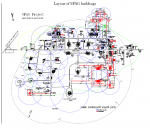
Source : https://www.isro.gov.in/sites/default/files/tenders/pt10-05-11469.pdf

Source : https://www.isro.gov.in/sites/default/files/tenders/pt10-05-11469.pdf
Isro to study tech needed to send Indians to moon
By Raghu Krishnan, Ayan Pramanik
Jan 23, 2020, 08.17 AM IST
India’s plan to work on human moon mission comes at a time when there is revival of interest globally for a return landing of a human on earth’s satellite. US space agency National Aeronautics and Space Administration expects to return to the moon with a man-woman team in 2024.

Isro usually plans its space programmes with a small team doing a feasibility study, publishing papers and then seeking grants from the government to do technology development.
BENGALURU: India’s space agency has set up a two-member team to study the technologies needed to send a human mission to the moon, people familiar with the development said. This will be an extension of its human spaceflight programme Gaganyaan.
The mission by the Indian Space Research Organisation (Isro) will need powerful rockets, as well as a capsule to carry human beings and return them safely back to earth.
The team is also expected to identify gaps in technologies that Isro will need to plug before undertaking such a mission.
“The team has been formed to look at a (human) mission to the moon,” said a space agency official who did not want to be named. It is too early to put a timeline for such a mission, the person said.
India’s plan to work on human moon mission comes at a time when there is revival of interest globally for a return landing of a human on earth’s satellite. US space agency National Aeronautics and Space Administration expects to return to the moon with a man-woman team in 2024.
Technology entrepreneurs Elon Musk and Jeff Bezos have also lined up plans for manned missions to the moon with SpaceX’s StarShip and Blue Origin’s Blue Moon spacecraft around the same time. China, too, has embarked on a human mission to the moon, which is expected sometime in the 2030s.
India’s mission, however, could take longer, said another person.
Isro usually plans its space programmes with a small team doing a feasibility study, publishing papers and then seeking grants from the government to do technology development.
Once the technologies that are strategic to the country are built and demonstrated, the space agency expands it into a programme team and works on a timeline to launch the mission. In most cases, a programme is announced only after government approval.
For example, Isro began preliminary work on its human spaceflight programme in the late 1990s, which it expected to launch in eight years.
But, only after the government approved the programme in 2018 did Isro move it to mission-mode to prepare to send a person to space using its own rocket and crew capsule by 2022.
GLOBAL REVIVAL IN HUMAN MOON MISSIONS :
By Raghu Krishnan, Ayan Pramanik
Jan 23, 2020, 08.17 AM IST
India’s plan to work on human moon mission comes at a time when there is revival of interest globally for a return landing of a human on earth’s satellite. US space agency National Aeronautics and Space Administration expects to return to the moon with a man-woman team in 2024.

Isro usually plans its space programmes with a small team doing a feasibility study, publishing papers and then seeking grants from the government to do technology development.
BENGALURU: India’s space agency has set up a two-member team to study the technologies needed to send a human mission to the moon, people familiar with the development said. This will be an extension of its human spaceflight programme Gaganyaan.
The mission by the Indian Space Research Organisation (Isro) will need powerful rockets, as well as a capsule to carry human beings and return them safely back to earth.
The team is also expected to identify gaps in technologies that Isro will need to plug before undertaking such a mission.
“The team has been formed to look at a (human) mission to the moon,” said a space agency official who did not want to be named. It is too early to put a timeline for such a mission, the person said.
India’s plan to work on human moon mission comes at a time when there is revival of interest globally for a return landing of a human on earth’s satellite. US space agency National Aeronautics and Space Administration expects to return to the moon with a man-woman team in 2024.
Technology entrepreneurs Elon Musk and Jeff Bezos have also lined up plans for manned missions to the moon with SpaceX’s StarShip and Blue Origin’s Blue Moon spacecraft around the same time. China, too, has embarked on a human mission to the moon, which is expected sometime in the 2030s.
India’s mission, however, could take longer, said another person.
Isro usually plans its space programmes with a small team doing a feasibility study, publishing papers and then seeking grants from the government to do technology development.
Once the technologies that are strategic to the country are built and demonstrated, the space agency expands it into a programme team and works on a timeline to launch the mission. In most cases, a programme is announced only after government approval.
For example, Isro began preliminary work on its human spaceflight programme in the late 1990s, which it expected to launch in eight years.
But, only after the government approved the programme in 2018 did Isro move it to mission-mode to prepare to send a person to space using its own rocket and crew capsule by 2022.
GLOBAL REVIVAL IN HUMAN MOON MISSIONS :
- NASA expects to return to the moon with a man and woman with its Artemis mission in 2024
- Elon Musk and Jeff Bezos have lined up manned missions with SpaceX’s StarShip and Blue Origin’s Blue Moon
- China is planning a human Moon mission, set for takeoff in 2030s
A one-meter optical telescope under ISRO's NETRA Project for Space Situational Awareness (SSA) would come up in Hanle, Ladakh.

Optical Telescope under NETRA Project
Source : PDF
Earlier we have seen an EoI for radar based tracking facility but location for it was not specified. From a recent news report on NETRA :
We know about MOTR at SHAR and we have also heard about optical tracking facility coming up at Guru Shikhar, Mount Abu. Perhaps this third one "deep in north" is referring to this facility in Hanle which is also home to other Indian astronomy telescopes (Chandra, HAGAR).
And then few weeks ago ISRO signed an MoU with IIA on "cooperation in the field of Space Situational Awareness (SSA)"
Source : MoU between ISRO and IIA - ISRO
So Hanle will be home to 4 telescopes now : Himalayan Chandra, HAGAR, MACE and this. Of course HiGRO is set to come up too.
HAGAR in Hanle :
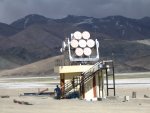

Optical Telescope under NETRA Project
Source : PDF
NEtwork for space object TRacking and Analysis (NETRA) is the first ISRO project with the primary objective as Space Situational Awareness (SSA). The prime goal of the project is to establish a network of observational facilities and a control centre, to identify, track and catalogue space objects that threaten the safety of Indian space assets. The control centre will process the tracking information from the observational network and provide accurate & timely proximity alerts to mission operations centre. For this purpose, ISRO invites proposals for the supply, installation and commissioning of Optical Telescope System with all the necessary mechanical, electrical, electronic and software systems for the above-mentioned applications. The location for establishing the optical telescope facility is identified as Hanle, Ladakh in INDIA.
It is intended that a one-meter optical telescope with a high-resolution CCD camera should provide capability of detecting space objects of size 30 cm and above in Geo-Synchronous Orbit (GSO). ISRO invites proposals from reputed vendors who have requisite experience in this field to design, manufacture, install and commission the total system end-to-end in Hanle, Ladakh. The total system will be known as Netra Telescope.
Earlier we have seen an EoI for radar based tracking facility but location for it was not specified. From a recent news report on NETRA :
ISRO has decided to set up telescopes and radars in four corners of the country. “Our sophisticated multi-object tracking radar installed in Nellore (90km from Sriharikota) will be part of this project. We will also set up a telescope in Ponmudi (Thiruvananthapuram) and second one in Mount Abu (Rajasthan) and third one in deep north.
We know about MOTR at SHAR and we have also heard about optical tracking facility coming up at Guru Shikhar, Mount Abu. Perhaps this third one "deep in north" is referring to this facility in Hanle which is also home to other Indian astronomy telescopes (Chandra, HAGAR).
And then few weeks ago ISRO signed an MoU with IIA on "cooperation in the field of Space Situational Awareness (SSA)"
MOU is signed as part of ISROs initiatives to utilize the efforts of Indian Academic Institutions in the space technology. This MoU will pave the way for future collaborations between ISRO and IIA in establishing optical telescope facilities under NETRA Project for space object tracking, studies related to space weather, Asteroids, and other Near Earth Objects (NEO). Collaboration between ISRO and IIA will help in progressing various fields of Astrophysics and Astronomy as well.
Source : MoU between ISRO and IIA - ISRO
So Hanle will be home to 4 telescopes now : Himalayan Chandra, HAGAR, MACE and this. Of course HiGRO is set to come up too.

HAGAR in Hanle :


‘Industrialised’ PSLV by 2022
Special Correspondent
THIRUVANANTHAPURAM, January 25, 2020 00:28 IST

Governor Arif Mohammad Khan presenting the Sree Chithira Thirunal Award-2019 to ISRO Chairman K. Sivan at a function in Thiruvananthapuram on Friday | Photo Credit: S MAHINSHA
This is the first vehicle manufactured by industry as a whole product
The first Polar Satellite Launch Vehicle (PSLV) fully built by the industry will be rolled out in 2022, K. Sivan, Chairman, Indian Space Research Organisation (ISRO), said on Friday.
Mr. Sivan was speaking after accepting the Sree Chithira Thirunal National Award - 2019 from Governor Arif Mohammad Khan. “Very soon, the PSLV will be manufactured by the industry as a whole product,” he said. The ISRO has announced plans to outsource the PSLV to the industry so that it can focus on other research areas and important missions.
Developmental flight
The first developmental flight of the Small Satellite Launch Vehicle (SSLV) is expected in April this year, he said. This mission will be carried out from Sriharikota. The process of acquiring 2,300 acres at Kulasekharapattanam in southern Tamil Nadu for establishing a launch facility for the SSLV is in progress, he added.
“The SSLV is conceived as a potential low-cost access to space. It will cater to the large number of small satellite launch requirements. Launching from Sriharikota would, however, hamper regular launches,” he explained the reason for establishing the new launch pad.
Astronauts for the Gaganyaan mission were picked after rigorous medical and psychological screening, Mr. Sivan said. “A series of tests are planned in 2020 to validate the design and engineering aspects of the launch vehicle systems.”
He also reiterated ISRO’s decision to perform the first unmanned test flight by this year-end.
‘Industrialised’ PSLV by 2022
Special Correspondent
THIRUVANANTHAPURAM, January 25, 2020 00:28 IST

Governor Arif Mohammad Khan presenting the Sree Chithira Thirunal Award-2019 to ISRO Chairman K. Sivan at a function in Thiruvananthapuram on Friday | Photo Credit: S MAHINSHA
This is the first vehicle manufactured by industry as a whole product
The first Polar Satellite Launch Vehicle (PSLV) fully built by the industry will be rolled out in 2022, K. Sivan, Chairman, Indian Space Research Organisation (ISRO), said on Friday.
Mr. Sivan was speaking after accepting the Sree Chithira Thirunal National Award - 2019 from Governor Arif Mohammad Khan. “Very soon, the PSLV will be manufactured by the industry as a whole product,” he said. The ISRO has announced plans to outsource the PSLV to the industry so that it can focus on other research areas and important missions.
Developmental flight
The first developmental flight of the Small Satellite Launch Vehicle (SSLV) is expected in April this year, he said. This mission will be carried out from Sriharikota. The process of acquiring 2,300 acres at Kulasekharapattanam in southern Tamil Nadu for establishing a launch facility for the SSLV is in progress, he added.
“The SSLV is conceived as a potential low-cost access to space. It will cater to the large number of small satellite launch requirements. Launching from Sriharikota would, however, hamper regular launches,” he explained the reason for establishing the new launch pad.
Astronauts for the Gaganyaan mission were picked after rigorous medical and psychological screening, Mr. Sivan said. “A series of tests are planned in 2020 to validate the design and engineering aspects of the launch vehicle systems.”
He also reiterated ISRO’s decision to perform the first unmanned test flight by this year-end.
‘Industrialised’ PSLV by 2022
India, co-builder of Hawaii telescope, wants it shifted out of proposed site
The $2 billion project , a joint venture involving five countries, has been marred by protests for over a decade; proposed site is considered sacred to the island’s indigenous people.
India, a partner in the construction of one of the largest telescopes in the world, has said it wants the project to be moved out of the proposed site at Mauna Kea, a dormant volcano in Hawaii.
The TMT or Thirty Metre Telescope, as it is called, is a joint venture (JV) involving five countries, but the $2 billion project has been marred by protests for over a decade. The proposed site is considered sacred to indigenous Hawaiians, and also has too many observatories for one more such massive establishment to come up, say groups that have contested the site.
India’s position has been clear. We would like the project to move to an alternate site if all the procedures and permits there are in place,” Ashutosh Sharma, Secretary, Department of Science and Technology, told The Hindu. “The difficulty is that even if construction [in Mauna Kea] were to go ahead, there could be future agitations,” he added.
Protests at the site last year saw scientists unable to access other telescope facilities in Mauna Kea. The project has been delayed by nearly five years and should have begun operations by 2025. India has committed $200 million, which is about a tenth of the proposed cost. The telescope needs 492 precisely polished mirrors and India is to contribute 83 of them. The project delay has meant that these manufacturing contracts have also been delayed.
Next best
The next best site to locate the telescope is the Observatorio del Roque de los Muchachos (ORM) on La Palma in the Canary Islands, Spain.
Hanle, in Ladakh, was also in the running to host the TMT, but lost out to Mauna Kea, which is considered a superior site due to the imaging possibilities it offers, its stable weather, and also because it has the necessary infrastructure to manage telescopes, already being host to several telescopes.
“The TMT will enable scientists to study fainter objects far away from us in the universe, which gives information about early stages of evolution of the universe. Also, it will give us finer details of not-so-far-away objects like undiscovered planets and other objects in the Solar System and planets around other stars,” said a note from the Press Information Bureau in April 2018.
Litigious site
The TMT has been a litigious site since 2014. In 2018, the Supreme Court of Hawaii gave permission for construction to proceed but the project’s proponents have not made progress because they were obstructed twice, in 2015 and 2019, respectively, from construction.
Canada, the United States, China and Japan are the other — and more significant — partners in terms of the monetary and infrastructural aspects of the TMT. The level of contribution determines the amount of viewing time, or slots, that the member-countries’ scientists get on the machine. Thus India, in a given year, stands to get 10% of the available slots; any downtime could potentially eat into those.
Representatives from member countries are expected to convene in Los Angeles in February to decide on project modalities. “By this year, we have to take a firm call on where the project has to be located,” said Eswar Reddy, Programme Director, India-TMT.
India too has its problems with hosting ambitious science projects. The Indian Neutrino Observatory, proposed to come up in Theni, Tamil Nadu, has also been stalled due to protests against the project in the State.
India, co-builder of Hawaii telescope, wants it shifted out of proposed site
The $2 billion project , a joint venture involving five countries, has been marred by protests for over a decade; proposed site is considered sacred to the island’s indigenous people.
India, a partner in the construction of one of the largest telescopes in the world, has said it wants the project to be moved out of the proposed site at Mauna Kea, a dormant volcano in Hawaii.
The TMT or Thirty Metre Telescope, as it is called, is a joint venture (JV) involving five countries, but the $2 billion project has been marred by protests for over a decade. The proposed site is considered sacred to indigenous Hawaiians, and also has too many observatories for one more such massive establishment to come up, say groups that have contested the site.
India’s position has been clear. We would like the project to move to an alternate site if all the procedures and permits there are in place,” Ashutosh Sharma, Secretary, Department of Science and Technology, told The Hindu. “The difficulty is that even if construction [in Mauna Kea] were to go ahead, there could be future agitations,” he added.
Protests at the site last year saw scientists unable to access other telescope facilities in Mauna Kea. The project has been delayed by nearly five years and should have begun operations by 2025. India has committed $200 million, which is about a tenth of the proposed cost. The telescope needs 492 precisely polished mirrors and India is to contribute 83 of them. The project delay has meant that these manufacturing contracts have also been delayed.
Next best
The next best site to locate the telescope is the Observatorio del Roque de los Muchachos (ORM) on La Palma in the Canary Islands, Spain.
Hanle, in Ladakh, was also in the running to host the TMT, but lost out to Mauna Kea, which is considered a superior site due to the imaging possibilities it offers, its stable weather, and also because it has the necessary infrastructure to manage telescopes, already being host to several telescopes.
“The TMT will enable scientists to study fainter objects far away from us in the universe, which gives information about early stages of evolution of the universe. Also, it will give us finer details of not-so-far-away objects like undiscovered planets and other objects in the Solar System and planets around other stars,” said a note from the Press Information Bureau in April 2018.
Litigious site
The TMT has been a litigious site since 2014. In 2018, the Supreme Court of Hawaii gave permission for construction to proceed but the project’s proponents have not made progress because they were obstructed twice, in 2015 and 2019, respectively, from construction.
Canada, the United States, China and Japan are the other — and more significant — partners in terms of the monetary and infrastructural aspects of the TMT. The level of contribution determines the amount of viewing time, or slots, that the member-countries’ scientists get on the machine. Thus India, in a given year, stands to get 10% of the available slots; any downtime could potentially eat into those.
Representatives from member countries are expected to convene in Los Angeles in February to decide on project modalities. “By this year, we have to take a firm call on where the project has to be located,” said Eswar Reddy, Programme Director, India-TMT.
India too has its problems with hosting ambitious science projects. The Indian Neutrino Observatory, proposed to come up in Theni, Tamil Nadu, has also been stalled due to protests against the project in the State.
India, co-builder of Hawaii telescope, wants it shifted out of proposed site
ISRO Gaganyaan Mission, Space Station Project Get French Helping Aid
By Sharmishte Datti | Published: Monday, January 27, 2020, 12:21 IST
India has planned out a couple of space exploration projects for the coming decade. As part of this, the ISRO Space Station project will be getting a French helping hand. France's National Center for Space Studies (CNES) is already collaborating with the ISRO Gaganyaan mission and will further aid with ISRO's space station project.
The New Indian Express reports that the French space agency and its collaborating industries have a good foothold in the Automated Transfer Vehicle (ATV) and with operations like the International Space Station. Together, ISRO and CNES have chalked a draft agreement, where the French agency will also provide training for the Indian astronauts and continue for the space station project.
CNES For Gaganyaan Mission
Most likely, the four Indian astronauts for the Gaganyaan mission will receive training by Novespace, a CNES subsidiary, on parabolic flights aboard the Air Zero Gravity, which is a modified version of the Airbus A310. The experience will give astronauts a zero-gravity environment on Earth.
CNES equipment for life support will also be provided for Indian astronauts. Other devices like health monitoring, eyewear equipment with Bluetooth connection, astronaut garments with biomedical sensors, aquapad cotton for quick and easy testing of water, specific equipment for waste management, or even food packaging will be provided by CNES.
Additionally, CNES will provide expert services at CADMOS, which is the control center in charge of operating the science and physiological experiments on the ISS. The center prepares the instruments and equipment required by the astronauts on ISS. The service will take place at MEDES space medicine research facility and hospital, in collaboration with ESA's European Astronaut Center (EAC), the report notes.
Additional Equipment For Gaganyaan Mission
Astronauts preparing for the Gaganyaan mission may use additional devices like ECHO, an ultrasound system teleoperated by doctors on the ground. The Cardiomed, a device used to measure cardiovascular activity might also be shipped. CNES expert Dr. Brigitte Godard has already spent time during July and August in Bengaluru to train physicians and personnel, a CNES official Jean-Yves Le Gall said.
For now, the astronauts will begin training in Russia. Physicians and engineers in the Gaganyaan mission will also be trained in France. The training will be given at MEDES space medicine and physiology institute in Toulouse and by the teams at ESA's astronaut training center in Cologne, The New Indian Express reports.
ISRO Gaganyaan Mission, Space Station Project Get French Helping Aid
By Sharmishte Datti | Published: Monday, January 27, 2020, 12:21 IST
India has planned out a couple of space exploration projects for the coming decade. As part of this, the ISRO Space Station project will be getting a French helping hand. France's National Center for Space Studies (CNES) is already collaborating with the ISRO Gaganyaan mission and will further aid with ISRO's space station project.
The New Indian Express reports that the French space agency and its collaborating industries have a good foothold in the Automated Transfer Vehicle (ATV) and with operations like the International Space Station. Together, ISRO and CNES have chalked a draft agreement, where the French agency will also provide training for the Indian astronauts and continue for the space station project.
CNES For Gaganyaan Mission
Most likely, the four Indian astronauts for the Gaganyaan mission will receive training by Novespace, a CNES subsidiary, on parabolic flights aboard the Air Zero Gravity, which is a modified version of the Airbus A310. The experience will give astronauts a zero-gravity environment on Earth.
CNES equipment for life support will also be provided for Indian astronauts. Other devices like health monitoring, eyewear equipment with Bluetooth connection, astronaut garments with biomedical sensors, aquapad cotton for quick and easy testing of water, specific equipment for waste management, or even food packaging will be provided by CNES.
Additionally, CNES will provide expert services at CADMOS, which is the control center in charge of operating the science and physiological experiments on the ISS. The center prepares the instruments and equipment required by the astronauts on ISS. The service will take place at MEDES space medicine research facility and hospital, in collaboration with ESA's European Astronaut Center (EAC), the report notes.
Additional Equipment For Gaganyaan Mission
Astronauts preparing for the Gaganyaan mission may use additional devices like ECHO, an ultrasound system teleoperated by doctors on the ground. The Cardiomed, a device used to measure cardiovascular activity might also be shipped. CNES expert Dr. Brigitte Godard has already spent time during July and August in Bengaluru to train physicians and personnel, a CNES official Jean-Yves Le Gall said.
For now, the astronauts will begin training in Russia. Physicians and engineers in the Gaganyaan mission will also be trained in France. The training will be given at MEDES space medicine and physiology institute in Toulouse and by the teams at ESA's astronaut training center in Cologne, The New Indian Express reports.
ISRO Gaganyaan Mission, Space Station Project Get French Helping Aid
Isro to launch 10 satellites to replace its ageing fleet
By Ayan Pramanik
Last Updated: Jan 29, 2020, 08.31 AM IST
By PTI
The first such satellite, GSAT-30, which will replace the 15-year-old INSAT 4-A satellite, was launched on January 17. The satellite carried 12 C band transponders for communication and 12 Ku band transponders designed for direct-to-home transmission.

Agency plans throughput satellites that can beam high-speed internet
BENGALURU: India plans to replace more than 10 communication satellites over the next few years as they near the end of their life in orbit, the country’s space agency chairman told ET. The plan includes launching high throughput satellites that can beam high-speed internet at more than 300 gigabytes per second into remote corners, said K Sivan of the Indian Space Research Organisation (Isro).
The first such satellite, GSAT-30, which will replace the 15-year-old INSAT 4-A satellite, was launched on January 17. The satellite carried 12 C band transponders for communication and 12 Ku band transponders designed for direct-to-home transmission. “One of the (important) plans is that wherever we have our ageing satellites, we will have to replace them,” Sivan said. “We need to have advanced technology (enabled) satellites in the areas of communication, navigation and earth observation.”
Isro’s communication satellites that hover in geostationary transfer orbit (GTO) 36,000 kilometres above the earth, are designed for a lifespan of 12-15 years.
As the existing fleet of satellites age, Isro has begun to replace them with more powerful ones to aid in communication, internet and television broadcast. There are 17 operational satellites including GSAT-30.
Analysts suggest satellites that have completed nearly 15 years need replacement as technology changes. “Technologies progress a lot in 15 years and there are satellites which are 15 years old and they need replacement. The second aspect is, both strategic and commercial needs are increasing equally,” said Ajey Lele, senior fellow at the Institute for Defence Studies and Analyses.
Even as demand for transponders peak, Isro is struggling to meet its target of 500 transponders. “Communication requirements are increasing day-by-day. There are agencies that are hiring transponders of foreign satellites. If you look at the number of transponders Isro has (it is huge). At one point in time, Isro had an ambitious plan (of having 500 transponders), but they are still trying to achieve that,” Lele said.
Isro to launch 10 satellites to replace its ageing fleet
By Ayan Pramanik
Last Updated: Jan 29, 2020, 08.31 AM IST
By PTI
The first such satellite, GSAT-30, which will replace the 15-year-old INSAT 4-A satellite, was launched on January 17. The satellite carried 12 C band transponders for communication and 12 Ku band transponders designed for direct-to-home transmission.

Agency plans throughput satellites that can beam high-speed internet
BENGALURU: India plans to replace more than 10 communication satellites over the next few years as they near the end of their life in orbit, the country’s space agency chairman told ET. The plan includes launching high throughput satellites that can beam high-speed internet at more than 300 gigabytes per second into remote corners, said K Sivan of the Indian Space Research Organisation (Isro).
The first such satellite, GSAT-30, which will replace the 15-year-old INSAT 4-A satellite, was launched on January 17. The satellite carried 12 C band transponders for communication and 12 Ku band transponders designed for direct-to-home transmission. “One of the (important) plans is that wherever we have our ageing satellites, we will have to replace them,” Sivan said. “We need to have advanced technology (enabled) satellites in the areas of communication, navigation and earth observation.”
Isro’s communication satellites that hover in geostationary transfer orbit (GTO) 36,000 kilometres above the earth, are designed for a lifespan of 12-15 years.
As the existing fleet of satellites age, Isro has begun to replace them with more powerful ones to aid in communication, internet and television broadcast. There are 17 operational satellites including GSAT-30.
Analysts suggest satellites that have completed nearly 15 years need replacement as technology changes. “Technologies progress a lot in 15 years and there are satellites which are 15 years old and they need replacement. The second aspect is, both strategic and commercial needs are increasing equally,” said Ajey Lele, senior fellow at the Institute for Defence Studies and Analyses.
Even as demand for transponders peak, Isro is struggling to meet its target of 500 transponders. “Communication requirements are increasing day-by-day. There are agencies that are hiring transponders of foreign satellites. If you look at the number of transponders Isro has (it is huge). At one point in time, Isro had an ambitious plan (of having 500 transponders), but they are still trying to achieve that,” Lele said.
Isro to launch 10 satellites to replace its ageing fleet
Cartosat-3 images are so clear that you can tell a truck from a car, read road markings
Social media users have begun processing Cartosat-3 images released by ISRO to test their quality. The results are stunning.
By Sandhya Ramesh, 31 January, 2020 6:30 pm IST

A Cartosat-3 overview of Doha, as reprocessed by Twitter user @detresfa_ | Twitter @detresfa_
Bengaluru: You can see the parked cars and the road markings, even distinguish small vehicles from the larger ones — images taken by Cartosat-3, India’s most sophisticated satellite ever, are stunning observers with their clarity.
Earlier this month, the Indian Space Research Organisation (ISRO) released images captured by Cartosat-3 over Qatar.
The images are still being calibrated — or fine-tuned — to improve their quality, but even the unprocessed images offer a clear bird’s-eye view of the West Asian nation.
Meanwhile, social media users have begun processing the images released by ISRO to test their quality. The samples posted by one such Twitter user, @detresfa_, show a level of detail unprecedented for satellite images.
Zoomed-in images show vehicles slotted in parking lanes, which can be clearly seen as lines on the ground, and traffic too.

Photo credit: ISRO image reprocessed by Twitter user @detresfa_
Comparison with images of Doha taken by Cartosat-3 predecessor Cartosat-2 reveal the impressive leap in technology at play.

Photo credit: ISRO image reprocessed by Twitter user @detresfa_
Best in the world
Cartosat-3 is a third-generation advanced satellite with very high-resolution imaging capability. The satellite will be used for a variety of earth-observation applications, such as cartography, weather mapping, forest surveys, urban planning, coastal studies, mineral prospecting, and, of course, military purposes.
One of its most important uses will include disaster relief operations, where such high-resolution imaging over a vast swathe of area can help save hundreds of lives.
It is a panchromatic, multi-spectral and hyper-spectral satellite, all of which are characteristics that bolster the quality of images it captures.
Multi-spectral indicates that the satellite can see in three to 10 bands of the electromagnetic spectrum. The satellite’s multi-spectral resolution is 1.13 m with a 16 km swath in four bands.
Hyper-spectral suggests hundreds of thousands of narrow bands being imaged. The satellite’s hyper-spectral resolution is 12 m with 5 km swath.
Where Cartosat-3 stands out is in its panchromatic resolution. Panchromatic indicates its sight in the visible part of the spectrum — Cartosat-3 has a ground resolution of 0.25 m with 16 km swath. This means the satellite can pick out an object that is 25 cm long in an area 16 km wide.
Its imaging resolution is the highest ever developed by ISRO. Its panchromatic resolution is also the best known commercially for a satellite in orbit. With its imaging capacity, Cartosat-3 replaces WorldView-4, an American satellite with a resolution of 31cm.
The 1625-kg Cartosat-3 is the ninth satellite to be launched in the Cartosat series. The series has been active since 2005 with the launch of Cartosat-1 and will form a part of the ISRO’s Indian Remote Sensing Programme.
Cartosat-3 images are so clear that you can tell a truck from a car, read road markings
Social media users have begun processing Cartosat-3 images released by ISRO to test their quality. The results are stunning.
By Sandhya Ramesh, 31 January, 2020 6:30 pm IST

A Cartosat-3 overview of Doha, as reprocessed by Twitter user @detresfa_ | Twitter @detresfa_
Bengaluru: You can see the parked cars and the road markings, even distinguish small vehicles from the larger ones — images taken by Cartosat-3, India’s most sophisticated satellite ever, are stunning observers with their clarity.
Earlier this month, the Indian Space Research Organisation (ISRO) released images captured by Cartosat-3 over Qatar.
The images are still being calibrated — or fine-tuned — to improve their quality, but even the unprocessed images offer a clear bird’s-eye view of the West Asian nation.
Meanwhile, social media users have begun processing the images released by ISRO to test their quality. The samples posted by one such Twitter user, @detresfa_, show a level of detail unprecedented for satellite images.
Zoomed-in images show vehicles slotted in parking lanes, which can be clearly seen as lines on the ground, and traffic too.

Photo credit: ISRO image reprocessed by Twitter user @detresfa_
Comparison with images of Doha taken by Cartosat-3 predecessor Cartosat-2 reveal the impressive leap in technology at play.

Photo credit: ISRO image reprocessed by Twitter user @detresfa_
Best in the world
Cartosat-3 is a third-generation advanced satellite with very high-resolution imaging capability. The satellite will be used for a variety of earth-observation applications, such as cartography, weather mapping, forest surveys, urban planning, coastal studies, mineral prospecting, and, of course, military purposes.
One of its most important uses will include disaster relief operations, where such high-resolution imaging over a vast swathe of area can help save hundreds of lives.
It is a panchromatic, multi-spectral and hyper-spectral satellite, all of which are characteristics that bolster the quality of images it captures.
Multi-spectral indicates that the satellite can see in three to 10 bands of the electromagnetic spectrum. The satellite’s multi-spectral resolution is 1.13 m with a 16 km swath in four bands.
Hyper-spectral suggests hundreds of thousands of narrow bands being imaged. The satellite’s hyper-spectral resolution is 12 m with 5 km swath.
Where Cartosat-3 stands out is in its panchromatic resolution. Panchromatic indicates its sight in the visible part of the spectrum — Cartosat-3 has a ground resolution of 0.25 m with 16 km swath. This means the satellite can pick out an object that is 25 cm long in an area 16 km wide.
Its imaging resolution is the highest ever developed by ISRO. Its panchromatic resolution is also the best known commercially for a satellite in orbit. With its imaging capacity, Cartosat-3 replaces WorldView-4, an American satellite with a resolution of 31cm.
The 1625-kg Cartosat-3 is the ninth satellite to be launched in the Cartosat series. The series has been active since 2005 with the launch of Cartosat-1 and will form a part of the ISRO’s Indian Remote Sensing Programme.
Cartosat-3 images are so clear that you can tell a truck from a car, read road markings
Watch :
Take a look at 37 minute mark you will see a video of moving traffic as seen from orbit by one of Cartosats that can capture 1 minute videos through their 'Event Monitoring' cameras. Another clip is from 55 meter resolution, GEO imaging High Resolution Camera (GHRC) payload on GSAT-29 showing a rocket launch and its plume slowly dispersing due to wind shear ! It wasn't specified which launch was observed but probably it was from Second Launch Pad.
Take a look at 37 minute mark you will see a video of moving traffic as seen from orbit by one of Cartosats that can capture 1 minute videos through their 'Event Monitoring' cameras. Another clip is from 55 meter resolution, GEO imaging High Resolution Camera (GHRC) payload on GSAT-29 showing a rocket launch and its plume slowly dispersing due to wind shear ! It wasn't specified which launch was observed but probably it was from Second Launch Pad.
Soon, tech that can aid forces in ‘beyond enemy lines’ operations
Chethan Kumar | TNN | Updated: Feb 3, 2020, 20:50 IST

Photo: IRNSS-1F
BENGALURU: A special personnel tracker being developed for 'strategic use' holds the potential of aiding India’s armed forces sent on ‘beyond the enemy lines’ operations in the future, and the fact that the new technology is completely indigenous will mean more secrecy.
As part of its Indian Regional Navigation Satellite System (IRNSS), the Indian Space Research Organisation (Isro) has developed the technology for the said personnel tracker, and transferred the same to Defense PSU Bharat Electronics Limited (BEL).
This technology is not part of the regular chipsets or other receivers developed as part of IRNSS programme. This will be part of ‘Restricted Service’ (IRNSS-RS), developed specifically for strategic users of the country, a source from the department of space, said.
Isro has been quiet about this technology, which has been in the works for at least 18 months now. One official Isro document that partially explains this and other IRNSS-RS technologies, reads: “The IRNSS–RS provides location navigation service with anti-spoofing technology for authorized users. Personnel Tracker gives position information in TDMA mode of operation.”
TDMA or time-division multiple access mode — which separates users according to time — ensures that there will be no interference from simultaneous transmissions, while anti-spoofing technology prevents traffic from false sources (IP addresses).
In a written reply to TOI on whether it was developing a personnel tracker, BEL said: “BEL has signed an agreement with Isro for development of a two-way reporting terminal and personnel tracker based on IRNSS. The two-way reporting terminal will be used to track the position of fishing vessels and reporting emergencies. The personnel tracker will be a one way reporting terminal for reporting the position of person/vehicle based on IRNSS.”
Elaborating on this, sources said given that IRNSS covers the entire sub-continent region, if a team of armed forces personnel “were on a job on the other side (of the border), their commanders back home will know their exact position at all times.”
The Isro document further read: “The tracker supports small message as well as data transfer through satellite and USB/Bluetooth user data interface. This tracker will be used to track the person in the field of operation in situations like disaster rescue operation, surveillance etc.”
When asked a specific question on its uses in “beyond enemy lines” operations, Isro chairman K Sivan told TOI: “I don’t want to elaborate on this question as it is a strategic project.” On the benefits of tracking ships and personnel, he said: “It has complete strategic uses, we shouldn’t discuss it now.”
Sources said that the fact this technology would be working on completely indigenous technology, including the satellite used to get the location — longitude and latitude — makes it more suitable for such operations.
Before IRNSS, while India could, using its remote sensing satellites map areas of operations, it had to depend on foreign resources like the GPS for location and navigation services. “Now, the data will remain with us and only us,” another source said.
Apart from this technology, BEL, working jointly with Isro has developed a portable IRNSS Receiver for navigation applications. “As an offshoot of this programme, BEL has developed variants based on IRNSS-RS receiver functionality such as PTS (Precision Time Servers) in both rack mount and wall mount form factors and receivers with Map-based navigation application.”
Soon, tech that can aid forces in ‘beyond enemy lines’operations | India News - Times of India
Chethan Kumar | TNN | Updated: Feb 3, 2020, 20:50 IST

Photo: IRNSS-1F
BENGALURU: A special personnel tracker being developed for 'strategic use' holds the potential of aiding India’s armed forces sent on ‘beyond the enemy lines’ operations in the future, and the fact that the new technology is completely indigenous will mean more secrecy.
As part of its Indian Regional Navigation Satellite System (IRNSS), the Indian Space Research Organisation (Isro) has developed the technology for the said personnel tracker, and transferred the same to Defense PSU Bharat Electronics Limited (BEL).
This technology is not part of the regular chipsets or other receivers developed as part of IRNSS programme. This will be part of ‘Restricted Service’ (IRNSS-RS), developed specifically for strategic users of the country, a source from the department of space, said.
Isro has been quiet about this technology, which has been in the works for at least 18 months now. One official Isro document that partially explains this and other IRNSS-RS technologies, reads: “The IRNSS–RS provides location navigation service with anti-spoofing technology for authorized users. Personnel Tracker gives position information in TDMA mode of operation.”
TDMA or time-division multiple access mode — which separates users according to time — ensures that there will be no interference from simultaneous transmissions, while anti-spoofing technology prevents traffic from false sources (IP addresses).
In a written reply to TOI on whether it was developing a personnel tracker, BEL said: “BEL has signed an agreement with Isro for development of a two-way reporting terminal and personnel tracker based on IRNSS. The two-way reporting terminal will be used to track the position of fishing vessels and reporting emergencies. The personnel tracker will be a one way reporting terminal for reporting the position of person/vehicle based on IRNSS.”
Elaborating on this, sources said given that IRNSS covers the entire sub-continent region, if a team of armed forces personnel “were on a job on the other side (of the border), their commanders back home will know their exact position at all times.”
The Isro document further read: “The tracker supports small message as well as data transfer through satellite and USB/Bluetooth user data interface. This tracker will be used to track the person in the field of operation in situations like disaster rescue operation, surveillance etc.”
When asked a specific question on its uses in “beyond enemy lines” operations, Isro chairman K Sivan told TOI: “I don’t want to elaborate on this question as it is a strategic project.” On the benefits of tracking ships and personnel, he said: “It has complete strategic uses, we shouldn’t discuss it now.”
Sources said that the fact this technology would be working on completely indigenous technology, including the satellite used to get the location — longitude and latitude — makes it more suitable for such operations.
Before IRNSS, while India could, using its remote sensing satellites map areas of operations, it had to depend on foreign resources like the GPS for location and navigation services. “Now, the data will remain with us and only us,” another source said.
Apart from this technology, BEL, working jointly with Isro has developed a portable IRNSS Receiver for navigation applications. “As an offshoot of this programme, BEL has developed variants based on IRNSS-RS receiver functionality such as PTS (Precision Time Servers) in both rack mount and wall mount form factors and receivers with Map-based navigation application.”
Soon, tech that can aid forces in ‘beyond enemy lines’operations | India News - Times of India
What Does India's Space Budget for 2020 Tell Us ?
It tells us that we have a production problem.
By Narayan Prasad

On February 1, finance minister Nirmala Sitharaman delivered the Union budget for 2020-2021, during which she announced an allocation of Rs 13,479.47 crore for the Department of Space (DOS). This is a 7.5% increase from last year – but a 45.2% increase relative to the allocation in 2015-2016. This signals India’s increasing, and continued, commitment to space activities.
Note that the Government of India has already approved a budget of Rs 10,911 crore for the construction of 30 Polar Satellite Launch Vehicles (PSLVs) and 10 Geostationary Satellite Launch Vehicles (GSLVs), and Rs 10,000 crore for the country’s maiden human spaceflight mission, ‘Gaganyaan’, which aims to send three astronauts to space.
Indeed, ISRO has been drawing from the success of its interplanetary missions to broaden its horizons and set up a Human Spaceflight Centre (HSFC) to train astronauts in a new campus in Karnataka’s Challakere, increase the number of Space Situational Awareness (SSA) projects (including Project NETRA) and to set up a dedicated control centre for SSA.
K. Sivan, the chairman of the Indian Space Research Organisation (ISRO), said at a recent press conference that the space agency intends to undertake 25 missions in 2020. Some of the more interesting among them, as well as other developments, include the launch of ISRO’s new Small Satellite Launch Vehicle (SSLV) to capture the emerging global small-satellites market; an effort to get back to the lunar surface with Chandrayaan 3; preparations for Gaganyaan; the establishment of a new launch pad in Kulasekarapattinam, in Tamil Nadu, to ease SSLV launches; and the launch of Aditya 1, India’s first space mission to study the Sun.
Interestingly, the NewSpace India, Ltd. (NSIL) – the public sector enterprise setup by the government to commercialise ISRO products – was given Rs 10 crore last year but nothing this budget. A.S. Kiran Kumar, Sivan’s predecessor at the helm of ISRO, had indicated three years ago that ISRO was exploring a consortium via a joint venture to build enough launch vehicles to support 24 launches a year. In retrospect, ISRO managed to conduct only six PSLV launches in 2019 and rented an Arianespace rocket to fly a geostationary satellite, instead of using a GSLV. So it looks like there hasn’t been much progress since Kumar’s statement, and this year’s allocation to NSIL suggests that the DOS has not made any concrete decisions about using NSIL to develop a joint effort with industry to augment India’s launch capacity.
Additionally, in October 2018, ISRO announced a roadmap to launch 50 satellites in a three-year period. The number of missions conducted in 2019 clearly indicates the lack of production capabilities within ISRO to support the burgeoning demand in the country for space-based services. Given the indifference towards making timely and strategic decisions towards creating an ecosystem of industry players that can augment the capacity, ISRO should perhaps consider tripling its workforce and increasing its in-house infrastructure to meet the demand by itself.
China has taken just this approach and today, state-owned and operated entities drive all major requirements. As a result, they were able to increase the number of launches to nearly 40 per year in 2018 from six in 2009. The same goes for supply-chain problems in realising enough satellites for all needs including weather, remote sensing, navigation, communications, science and experimental missions.
Another count on which we need to have some progress – and soon – is the formalisation of specific missions of the Defence Space Agency (DSA) and the Defence Space Research Organisation, which the government announced last year. The DSA is expected to employ 200 personnel together with existing capabilities in the Defence Imagery Processing and Analysis Centre, New Delhi, and the Defence Satellite Control Centre, Bhopal. However, the budget itself presented no more information nor do we know any mission timelines for these entities, conceived in an attempt to modernise the Indian armed forces with the integration of space technology.
Overall, the Government of India has been very supportive of the space programme and its ability to develop applications for society. However, the DOS has not been able to effectively address the problem of production to keep up with demand. Together with the fact that there have been no bold steps in increasing private sector participation in the space programme, the government should consider increasing both personnel and infrastructure instead. This seems to be the only way out as long as we also desire a balance between having the ability to focus on new technologies for spaceflight and having to undertake run-of-the-mill production of established space systems.
Narayan Prasad is the host of the NewSpace India podcast, India’s only talk show focused on space activities.
What Does India's Space Budget for 2020 Tell Us?
It tells us that we have a production problem.
By Narayan Prasad

On February 1, finance minister Nirmala Sitharaman delivered the Union budget for 2020-2021, during which she announced an allocation of Rs 13,479.47 crore for the Department of Space (DOS). This is a 7.5% increase from last year – but a 45.2% increase relative to the allocation in 2015-2016. This signals India’s increasing, and continued, commitment to space activities.
Note that the Government of India has already approved a budget of Rs 10,911 crore for the construction of 30 Polar Satellite Launch Vehicles (PSLVs) and 10 Geostationary Satellite Launch Vehicles (GSLVs), and Rs 10,000 crore for the country’s maiden human spaceflight mission, ‘Gaganyaan’, which aims to send three astronauts to space.
Indeed, ISRO has been drawing from the success of its interplanetary missions to broaden its horizons and set up a Human Spaceflight Centre (HSFC) to train astronauts in a new campus in Karnataka’s Challakere, increase the number of Space Situational Awareness (SSA) projects (including Project NETRA) and to set up a dedicated control centre for SSA.
K. Sivan, the chairman of the Indian Space Research Organisation (ISRO), said at a recent press conference that the space agency intends to undertake 25 missions in 2020. Some of the more interesting among them, as well as other developments, include the launch of ISRO’s new Small Satellite Launch Vehicle (SSLV) to capture the emerging global small-satellites market; an effort to get back to the lunar surface with Chandrayaan 3; preparations for Gaganyaan; the establishment of a new launch pad in Kulasekarapattinam, in Tamil Nadu, to ease SSLV launches; and the launch of Aditya 1, India’s first space mission to study the Sun.
Interestingly, the NewSpace India, Ltd. (NSIL) – the public sector enterprise setup by the government to commercialise ISRO products – was given Rs 10 crore last year but nothing this budget. A.S. Kiran Kumar, Sivan’s predecessor at the helm of ISRO, had indicated three years ago that ISRO was exploring a consortium via a joint venture to build enough launch vehicles to support 24 launches a year. In retrospect, ISRO managed to conduct only six PSLV launches in 2019 and rented an Arianespace rocket to fly a geostationary satellite, instead of using a GSLV. So it looks like there hasn’t been much progress since Kumar’s statement, and this year’s allocation to NSIL suggests that the DOS has not made any concrete decisions about using NSIL to develop a joint effort with industry to augment India’s launch capacity.
Additionally, in October 2018, ISRO announced a roadmap to launch 50 satellites in a three-year period. The number of missions conducted in 2019 clearly indicates the lack of production capabilities within ISRO to support the burgeoning demand in the country for space-based services. Given the indifference towards making timely and strategic decisions towards creating an ecosystem of industry players that can augment the capacity, ISRO should perhaps consider tripling its workforce and increasing its in-house infrastructure to meet the demand by itself.
China has taken just this approach and today, state-owned and operated entities drive all major requirements. As a result, they were able to increase the number of launches to nearly 40 per year in 2018 from six in 2009. The same goes for supply-chain problems in realising enough satellites for all needs including weather, remote sensing, navigation, communications, science and experimental missions.
Another count on which we need to have some progress – and soon – is the formalisation of specific missions of the Defence Space Agency (DSA) and the Defence Space Research Organisation, which the government announced last year. The DSA is expected to employ 200 personnel together with existing capabilities in the Defence Imagery Processing and Analysis Centre, New Delhi, and the Defence Satellite Control Centre, Bhopal. However, the budget itself presented no more information nor do we know any mission timelines for these entities, conceived in an attempt to modernise the Indian armed forces with the integration of space technology.
Overall, the Government of India has been very supportive of the space programme and its ability to develop applications for society. However, the DOS has not been able to effectively address the problem of production to keep up with demand. Together with the fact that there have been no bold steps in increasing private sector participation in the space programme, the government should consider increasing both personnel and infrastructure instead. This seems to be the only way out as long as we also desire a balance between having the ability to focus on new technologies for spaceflight and having to undertake run-of-the-mill production of established space systems.
Narayan Prasad is the host of the NewSpace India podcast, India’s only talk show focused on space activities.
What Does India's Space Budget for 2020 Tell Us?
VSSC plans to set up ro-ro jetty to move heavy equipment by sea
Movement of large consignments to big project sites is often accompanied by logistic woes.
Published: 07th February 2020 06:59 AM
By Shan A S
Express News Service

THIRUVANANTHAPURAM: Movement of large consignments to big project sites is often accompanied by logistic woes. At times, the trees along the route have to be trimmed and vehicular movement suspended so as to facilitate easy passage of huge trucks. The Vikram Sarabhai Space Centre (VSSC) at Thumba here was also staring at such a predicament.
They had to transport critical components, some of them weighing about 200 metric tonnes, for their upcoming project from various centres. Transporting them seemed to be an uphill task until the organization decided to set up a temporary ro-ro jetty at the beach, which will enable movement of consignments by sea.
As per the existing plans, the ro-ro jetty is expected to come up near Thumba Equatorial Rocket Launching Station (TERLS) area of VSSC. The jetty will be constructed using concrete blocks and containers and a permission in this regard was accorded by the Fisheries and Ports department.
Though the VSSC sources declined to reveal the details of the project, they said components were to be transported in 25-30 consignments and it was impossible to move them by road. “Some of the components are as long as 25m. Moving them by road is almost impossible,” the source said.
“Earlier, we used to move one or two truck loads via roads. We had to jack up the overhead electricity supply wires and cut down trees to move them. In the current case, moving 25-30 consignments in that manner is not possible,” the sources added.
As per the plans, the consignments will be brought in on barges from various factories and ISRO centres in the country. They will be lifted off the vessels using cranes.
As per the report filed by Harbour Engineering Department Chief Engineer, setting up of jetty will not cause any hindrance to the movement of fishing vessels or environmental damages. The expenses for the project will be borne by VSSC.
VSSC plans to set up ro-ro jetty to move heavy equipment by sea
Movement of large consignments to big project sites is often accompanied by logistic woes.
Published: 07th February 2020 06:59 AM
By Shan A S
Express News Service

THIRUVANANTHAPURAM: Movement of large consignments to big project sites is often accompanied by logistic woes. At times, the trees along the route have to be trimmed and vehicular movement suspended so as to facilitate easy passage of huge trucks. The Vikram Sarabhai Space Centre (VSSC) at Thumba here was also staring at such a predicament.
They had to transport critical components, some of them weighing about 200 metric tonnes, for their upcoming project from various centres. Transporting them seemed to be an uphill task until the organization decided to set up a temporary ro-ro jetty at the beach, which will enable movement of consignments by sea.
As per the existing plans, the ro-ro jetty is expected to come up near Thumba Equatorial Rocket Launching Station (TERLS) area of VSSC. The jetty will be constructed using concrete blocks and containers and a permission in this regard was accorded by the Fisheries and Ports department.
Though the VSSC sources declined to reveal the details of the project, they said components were to be transported in 25-30 consignments and it was impossible to move them by road. “Some of the components are as long as 25m. Moving them by road is almost impossible,” the source said.
“Earlier, we used to move one or two truck loads via roads. We had to jack up the overhead electricity supply wires and cut down trees to move them. In the current case, moving 25-30 consignments in that manner is not possible,” the sources added.
As per the plans, the consignments will be brought in on barges from various factories and ISRO centres in the country. They will be lifted off the vessels using cranes.
As per the report filed by Harbour Engineering Department Chief Engineer, setting up of jetty will not cause any hindrance to the movement of fishing vessels or environmental damages. The expenses for the project will be borne by VSSC.
VSSC plans to set up ro-ro jetty to move heavy equipment by sea
Looks like a model of ISRO's proposed space station. You can see the gaganyaan module attached to it on one end. There is a spherical module junction between the two segments. The first photo seen of the space station(2nd pic.) had no such junction. The junction seems designed to be able to mate 6 station modules. Each module can mate with two others, one on each end.
View attachment 13429
The space station was stated to be 20 tonnes. I presumed at that time that each module will weigh about 10 tonnes and both modules will be launched separately by GSLV MK-3 and then mated in space. With the addition of the junction module I wonder how the weight will be effected. OTOH having a junction allows us to expand the space station at a steady pace whenever budget is permitting.
View attachment 13430
Images from IAA-ISRO-ASI Human Spaceflight Programme Symposium (Jan 2020) via Pallava Bagla.
Gaganyaan Orbital Vehicle(CM+SM) shown with solar panels deployed.

Space station concept shown with Gaganyaan docked.
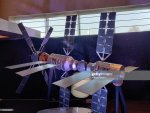
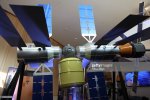



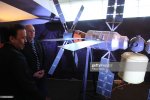
Seating arrangement inside Gaganyaan crew module :

Model of human rated GSLV Mk III with CES + CM + SM stack :
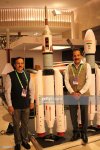
ISRO’s Space Station and Human Mission Programme: US Companies keen on space collaboration with India
By: Huma Siddiqui | Published: February 10, 2020 6:09:26 PM
Space agencies of the two countries will be launching the jointly developed NASA-ISRO Synthetic Aperture Radar (NISAR) satellite in 2022.

India will become a member of the elite club of countries once it has its own space station. (Photo: Representational by Reuters)
Topping the agenda of talks between India and the US leaders later this month will be potential space defence cooperation as well as deeper cooperation between Indian Space Research Organisation and the American Space Agency NASA. Besides lunar exploration and working on the Space Station, the two space agencies are seeking deeper cooperation in interplanetary and cooperation in the human space flight and Space Station. According to a senior officer who wished to remain anonymous “When the US President Donald Trump visits India later this month (dates have not been officially confirmed) Space Cooperation between ISRO and NASA and related areas will be on the agenda of talks at the delegation-level.”
So far ISRO’s Polar Satellite Launch Vehicle (PSLV) has been the chosen one as a low-cost launch option for the small satellites built by the American private sector. In September 2015, ISRO has launched four LEMUR remote sensing satellites, followed by the launch of several satellites built by the American private sector onboard Polar Satellite Launch Vehicle (PSLV). Last year, around thirteen commercial nano-satellites from the US were launched on PSLV.
Space agencies of the two countries will be launching the jointly developed NASA-ISRO Synthetic Aperture Radar (NISAR) satellite in 2022.
Beyond Launches
India and the US has already been started working together in the Satellite Navigation (SatNav). The US Congress has in principle decided to designate the Indian Regional Navigation Satellite System (IRNSS) or better known as the NaVIC as an “allied system”.
After the rigorous selection process for the first-ever manned mission Gaganyaan in 2022, four Indian astronauts will be going to Russia for advanced training. This is under the agreement between the Roscosmos State Corporation for Space Activities and ISRO.As part of the training, under this agreement, the Indian astronauts will go on a short visit to the International Space Station (ISS) on board a Soyuz spacecraft.
The US Space Agency NASA too is expected to play an important role in the Human Mission of ISRO by sharing its expertise as well as training facilities.
According to the joint statement released at the end of the second India-US 2+2 Dialogue last winter, both sides recognized space cooperation, including on Earth science and lunar exploration, as a critical component of the India-US relations.
India’s Space Diplomacy
In the recent years Space diplomacy has become a very important part of International Security. India offers not only economically feasible satellite launches, but has achieved major successes in the Space Sector including the Mars Mission. This itself has become a major attraction for the countries including the US, Russia, Japan, and China.
ISRO’s plan for the Space Station
According to sources, “Two top US companies are in talks with ISRO and want to be part of Space Station Programme of ISRO and other related areas of the Human Mission. The talks are in preliminary stages.”
India will become a member of the elite club of countries once it has its own space station.
What is a Space Station ?
It is an artificial satellite in low Earth Orbit and functions as a Space Station. So far there is only one International Space Station. This spacecraft has the capability to support the crew members and can stay in space for an extended period.
ISRO’s Space Station and Human Mission Programme: US Companies keen on space collaboration with India
By: Huma Siddiqui | Published: February 10, 2020 6:09:26 PM
Space agencies of the two countries will be launching the jointly developed NASA-ISRO Synthetic Aperture Radar (NISAR) satellite in 2022.

India will become a member of the elite club of countries once it has its own space station. (Photo: Representational by Reuters)
Topping the agenda of talks between India and the US leaders later this month will be potential space defence cooperation as well as deeper cooperation between Indian Space Research Organisation and the American Space Agency NASA. Besides lunar exploration and working on the Space Station, the two space agencies are seeking deeper cooperation in interplanetary and cooperation in the human space flight and Space Station. According to a senior officer who wished to remain anonymous “When the US President Donald Trump visits India later this month (dates have not been officially confirmed) Space Cooperation between ISRO and NASA and related areas will be on the agenda of talks at the delegation-level.”
So far ISRO’s Polar Satellite Launch Vehicle (PSLV) has been the chosen one as a low-cost launch option for the small satellites built by the American private sector. In September 2015, ISRO has launched four LEMUR remote sensing satellites, followed by the launch of several satellites built by the American private sector onboard Polar Satellite Launch Vehicle (PSLV). Last year, around thirteen commercial nano-satellites from the US were launched on PSLV.
Space agencies of the two countries will be launching the jointly developed NASA-ISRO Synthetic Aperture Radar (NISAR) satellite in 2022.
Beyond Launches
India and the US has already been started working together in the Satellite Navigation (SatNav). The US Congress has in principle decided to designate the Indian Regional Navigation Satellite System (IRNSS) or better known as the NaVIC as an “allied system”.
After the rigorous selection process for the first-ever manned mission Gaganyaan in 2022, four Indian astronauts will be going to Russia for advanced training. This is under the agreement between the Roscosmos State Corporation for Space Activities and ISRO.As part of the training, under this agreement, the Indian astronauts will go on a short visit to the International Space Station (ISS) on board a Soyuz spacecraft.
The US Space Agency NASA too is expected to play an important role in the Human Mission of ISRO by sharing its expertise as well as training facilities.
According to the joint statement released at the end of the second India-US 2+2 Dialogue last winter, both sides recognized space cooperation, including on Earth science and lunar exploration, as a critical component of the India-US relations.
India’s Space Diplomacy
In the recent years Space diplomacy has become a very important part of International Security. India offers not only economically feasible satellite launches, but has achieved major successes in the Space Sector including the Mars Mission. This itself has become a major attraction for the countries including the US, Russia, Japan, and China.
ISRO’s plan for the Space Station
According to sources, “Two top US companies are in talks with ISRO and want to be part of Space Station Programme of ISRO and other related areas of the Human Mission. The talks are in preliminary stages.”
India will become a member of the elite club of countries once it has its own space station.
What is a Space Station ?
It is an artificial satellite in low Earth Orbit and functions as a Space Station. So far there is only one International Space Station. This spacecraft has the capability to support the crew members and can stay in space for an extended period.
ISRO’s Space Station and Human Mission Programme: US Companies keen on space collaboration with India



